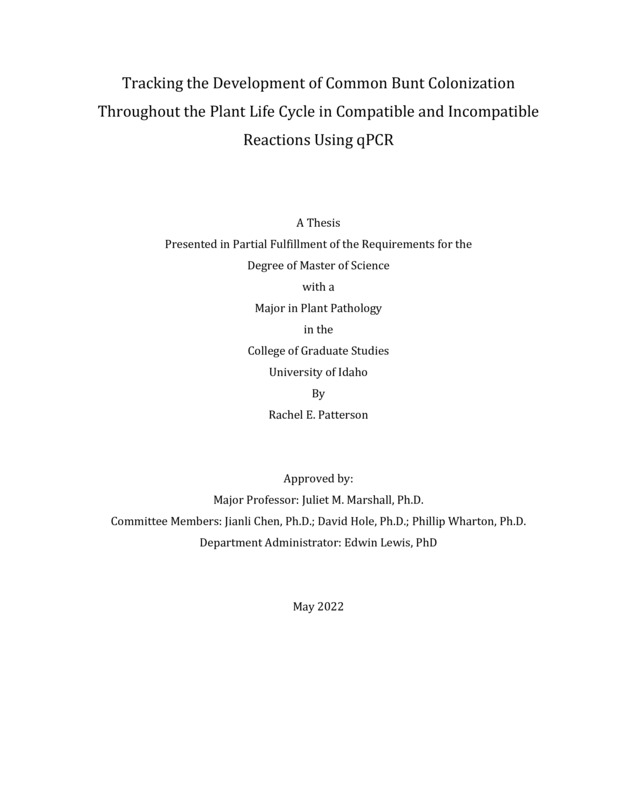Tracking the Development of Common Bunt Colonization Throughout the Plant Life Cycle in Compatible and Incompatible Reactions Using qPCR
Patterson, Rachel Elizabeth. (2022-05). Tracking the Development of Common Bunt Colonization Throughout the Plant Life Cycle in Compatible and Incompatible Reactions Using qPCR. Theses and Dissertations Collection, University of Idaho Library Digital Collections. https://www.lib.uidaho.edu/digital/etd/items/patterson_idaho_0089n_12375.html
- Title:
- Tracking the Development of Common Bunt Colonization Throughout the Plant Life Cycle in Compatible and Incompatible Reactions Using qPCR
- Author:
- Patterson, Rachel Elizabeth
- Date:
- 2022-05
- Embargo Remove Date:
- 2023-05-25
- Keywords:
- common bunt host resistance qPCR Tilletia
- Program:
- Entomology, Plant Path & Nematology
- Subject Category:
- Plant pathology; Plant sciences
- Abstract:
-
Common bunt, caused by Tilletia caries (A.P. de Candolle) L.-R. & C. Tulasne (syn. T. tritici (Bjerk.) G. Winter), and T. laevis J.G. Kühn (syn. T. foetida (Wallr.) Liro), is a reemerging disease that mainly impacts wheat. A seedborne pathogen, it germinates under the soil, infects the new coleoptiles, and colonizes the plant asymptomatically until heading at which point it replaces healthy ovarian tissue with balls of black spores that mature into lookalike kernels called sori or bunt balls. The sori break open during harvest, contaminating seed lots to complete the cycle. Once contaminated, seed will fetch a reduced price or be unsellable. The common bunt fungi are endemic in all wheat-growing regions globally, but they are very closely related to the dwarf bunt fungus, T. controversa Kühn which is a quarantine pathogen in some major markets. Due to the morphological similarities, compounded by hybridization between the three fungi, common bunt contaminated grain may be confused for dwarf bunt contaminated grain and be rejected in international markets. Although an extensive series of seed-treatment fungicides have been released for common bunt control, the most longstanding and useful tool to protect organic systems and volunteer plants, and reduce soil banks is the development of resistant varieties. Currently, sixteen major resistance genes named Bt1-Bt15 and Btp have been identified, of which Bt8 is the most successful gene in the Pacific Northwest. Breeding resistance into new varieties, and breeding resistant varieties for better agronomic performance, may require years as the disease is currently only rated at heading to maturity, one of the final growth stages in a months-long host life cycle. New technology to accurately identify infection is necessary to shorten breeding timelines, in order to continue to combat a pathogen that readily mutates and hybridizes. Developing that technology requires a better understanding of resistance. Thus far, only four studies on the histopathology of incompatible reactions have been published. Only one of them accounted for the specific genotypes of the hosts and pathogens used. The earlier studies agreed with each other that both incompatible and compatible reactions involve colonization of the host to the same degree until 15-21 days post-inoculation, mostly due to new infection events that are swiftly excluded, while the later study described damage as late as the tillering stage (Zadoks 21). The limited number of studies and the general lack of genotype reporting provides a limited understanding of how the common bunt fungi interact with the host resistance response, which if improved could accelerate the development of new technologies for identification and exclusion to reduce breeding timelines. To study the difference between incompatible and compatible reactions, one fully susceptible host and one Bt8 differential were challenged with one of two common bunt races, resulting in 3 compatible reactions and 1 incompatible reaction. Plants were sampled at 4 growth stages, with individual tissues excised and their DNA extracted. The objectives of this study were to (i) modify existing molecular approaches to develop a qPCR assay capable of quantifying the amount of common bunt DNA relative to the amount of host wheat DNA in a sample to (ii) determine the extent of earlier infection in two different host genotypes challenged with two different common bunt and (v) determine the differences in colonization and defense induction between compatible and incompatible reactions involving two different host and pathogen genotypes each at each studied growth stage races. The final objective was to (iv) investigate whether non-destructive samples taken earlier in the plant life cycle could be used as a tool for resistance breeding, to shorten the breeding cycle in the absence of QTL. The results indicated that there were no statistically significant differences in colonization patterns until the second node stage, at which point colonization was halted in a race-specific manner. The T. caries race was unable to cause disease in the incompatible reaction, and was only marginally successful in the compatible reaction. Due to a lack of consistent progressions of fungal colonization between compatible reactions of different host genotypes, and a markedly different resistance timeline development between Bt8 and Bt10, this study concludes that not only is resistance race-specific, it is also host-genotype dependent as is compatibility. This necessitates a higher level of genotype reporting for future studies on the subject, and more research into the general timing of resistance in incompatible reactions if a qPCR assay is to be utilized.
- Description:
- masters, M.S., Entomology, Plant Path & Nematology -- University of Idaho - College of Graduate Studies, 2022-05
- Major Professor:
- Marshall, Juliet
- Committee:
- Chen, Jianli; Wharton, Phillip; Hole, David; Lewis, Edwin
- Defense Date:
- 2022-05
- Identifier:
- Patterson_idaho_0089N_12375
- Type:
- Text
- Format Original:
- Format:
- application/pdf
- Rights:
- In Copyright - Educational Use Permitted. For more information, please contact University of Idaho Library Special Collections and Archives Department at libspec@uidaho.edu.
- Standardized Rights:
- http://rightsstatements.org/vocab/InC-EDU/1.0/

